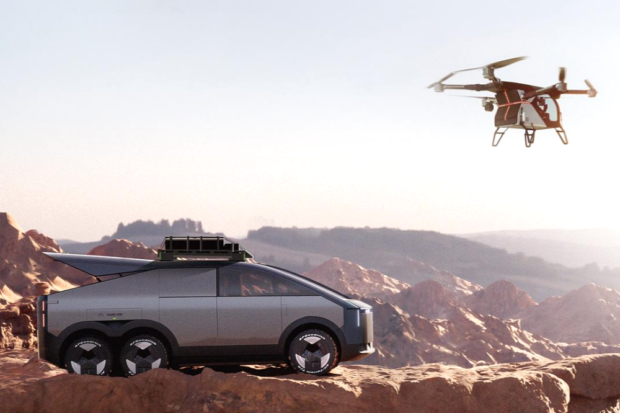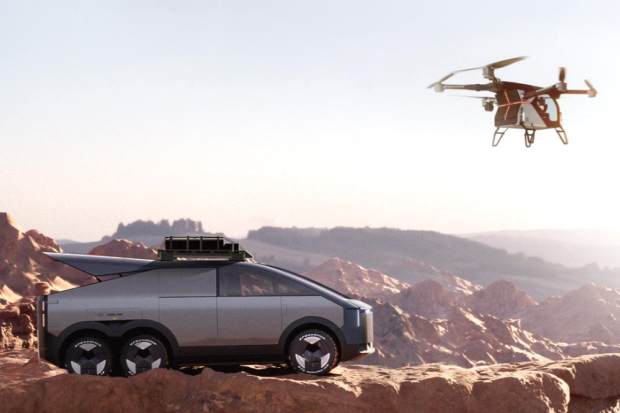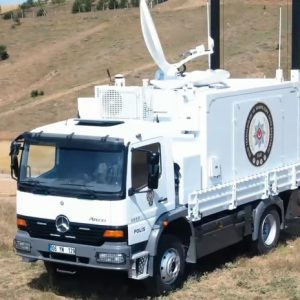A Chinese firm has emerged as a trailblazer, unveiling two futuristic Flying Car Designs Unveiled at CES that have captured the imagination of enthusiasts and industry experts alike. These groundbreaking designs are showcased at CES, exploring the technological marvels that may soon redefine the landscape of personal and urban air transportation.

The Unveiling: A Glimpse into the Future of Transportation
Futuristic Flying Car Designs
At CES, the Chinese firm showcased two distinct flying car designs, each embodying a vision of urban mobility that transcends conventional boundaries. These designs seamlessly integrate cutting-edge aerospace technology with innovative concepts, offering a tantalizing glimpse into the future of personal transportation.

Aerodynamic Mastery
The first design captivates with its sleek aerodynamic profile, emphasizing efficiency and performance. Drawing inspiration from advanced aerospace principles, the design optimizes lift and minimizes drag, ensuring a harmonious balance between speed and stability. The exterior design not only exudes elegance but also serves a functional purpose, contributing to enhanced flight dynamics.
Hybrid Propulsion System
Beneath the surface, this flying car incorporates a state-of-the-art hybrid propulsion system, seamlessly transitioning between vertical takeoff and horizontal flight. The integration of electric and traditional propulsion elements ensures not only efficient energy utilization but also a reduced environmental footprint. This aligns with the global push toward sustainable transportation solutions.
Vertical Takeoff Innovation
The second design stands out with its innovative vertical takeoff capabilities, leveraging advanced VTOL (Vertical Take-Off and Landing) technology. This feature holds tremendous promise for urban environments where space constraints necessitate agile and space-efficient aerial mobility solutions. The design prioritizes ease of takeoff and landing without compromising on performance during horizontal flight.
AI-Powered Navigation
An integral component of this design is its AI-powered navigation system, enhancing autonomous flight capabilities. The incorporation of artificial intelligence allows for real-time decision-making, obstacle detection, and adaptive navigation, ensuring a safe and reliable flying experience. This futuristic approach positions this flying car as a pioneer in the convergence of aerospace and artificial intelligence.
Technological Advancements: A Closer Look
Advanced Materials and Construction
Both flying car designs showcase the integration of advanced materials such as lightweight alloys, carbon composites, and cutting-edge polymers. These materials not only contribute to the structural integrity of the vehicles but also play a pivotal role in optimizing weight, thereby enhancing overall performance and energy efficiency.
Smart Cockpit and Connectivity
Inside the cockpit, a seamless fusion of smart technology and connectivity creates an immersive and intuitive experience for the pilot or passengers. Touchscreen interfaces, augmented reality displays, and real-time connectivity to navigation systems further elevate the flying experience, making it not only efficient but also user-friendly.
Urban Air Mobility: Addressing Challenges and Opportunities
Overcoming Regulatory Hurdles
As with any transformative technology, the adoption of flying cars faces regulatory challenges. However, the Chinese firm has demonstrated a commitment to working closely with regulatory bodies to address safety, airspace management, and certification requirements. This collaborative approach underscores a dedication to ensuring the responsible integration of flying cars into urban environments.
Environmental Considerations
The shift toward aerial mobility raises valid concerns about environmental impact. Both flying car designs prioritize sustainability through efficient propulsion systems, reduced emissions, and a focus on eco-friendly materials. As urban air mobility evolves, these considerations will play a crucial role in shaping the industry’s approach to environmental responsibility.
Market Implications and Future Prospects
Shaping the Future of Personal Transportation
The unveiling of these flying car designs marks a significant milestone in the evolution of personal transportation. As technology advances and regulatory frameworks mature, the prospect of incorporating flying cars into our daily lives becomes increasingly tangible. The market implications extend beyond individual commuters to impact industries such as logistics, emergency services, and urban planning.
Collaborative Industry Innovation
The emergence of these flying car designs serves as a catalyst for collaborative innovation within the aerospace industry. As companies worldwide witness the potential of urban air mobility, cross-industry partnerships, research initiatives, and technological advancements are likely to accelerate. This collaborative ecosystem is essential for addressing challenges, sharing insights, and collectively shaping the future of aerial transportation.
Conclusion: A Skyward Journey into Tomorrow
In conclusion, the unveiling of these two flying car designs at CES marks a pivotal moment in the trajectory of urban air mobility. At [Your Company Name], we remain vigilant observers of these technological advancements, recognizing the transformative potential they hold for the aerospace industry and beyond. As we navigate the skies of tomorrow, propelled by innovation and fueled by a collective vision for a more connected and efficient future, the era of flying cars beckons, promising a new dimension in personal and urban transportation.











